Abstract
In this study, we identified the echo signals of anchovies on echograms using the dB-difference method; additionally, the daytime and nighttime distribution characteristics of anchovies were determined. Using the difference in frequency characteristics of 18, 38, 70, 120, and 200 kHz, the dB-difference intervals of −2.1 dB ≤ ΔMVBS18–38 ≤ 4.4 dB, −9.7 dB ≤ ΔMVBS70–38 ≤ 1.3 dB, −10.2 dB ≤ ΔMVBS120–38 ≤ 2.3 dB, and −10.7 dB ≤ ΔMVBS200–38 ≤ 0.3 dB were set to extract the echo signals of anchovies. The results revealed that anchovies showed a relatively higher distribution in the coast than in the open sea. In February, the average density of anchovies was observed to be 3.43 g/m2, whereas in May, it was observed to be 6.02 g/m2. Also, anchovies were found to be mainly distributed at 30-70 m water depths during the day, and at 30–50 m water depths during the night.
1. Introduction
Korea is surrounded by the East, West, and South seas, with each sea showing distinct characteristics of the marine environment and inhabiting different fishery resources. The East Sea does not have any islands or bays, but has a monotonous coastline. The width of its continental shelf is quite narrow, <25 km, averaging around 18 km, and is considerably deeper than the South and West seas. Also, the East Sea is influenced by the high-temperature and high-salinity Tsushima Warm Current flowing into the Korea Strait, and the low-temperature and low-salt southward flow along the coast from the northern part of the East Sea; different water masses exist in different waters and depths due to deep water circulation, polar fronts, upwelling, and eddies [1,2]. The South Sea is a rias-type coast with many islands and large and small bays, and various water masses coexist, such as high-temperature and high-salinity Tsushima Warm Current from the south, low-salinity West Sea coastal water from the western Jeju Strait, and South Sea coastal water, which have a complex effect on the formation of fishing grounds [3]. Due to the formation of various water masses, the East and South seas are rich in nutrients which serve as feed stocks for organisms, and they are used as spawning and nursery grounds for fishery resources. Owing to these characteristics, the East and South seas are home to Scomber japonicus, Trachurus japonicus, Clupea pallasii and Engraulis japonicus and such, which are commercially important fishery resources in Korea.
However, in recent years, South Korea’s coastal fishery resources have shown a declining trend. In particular, fishing of anchovies with anchovy boat seine and set nets has been steadily decreasing; it decreased from 210,000 tons in 2017 to 130,000 tons in 2022 [4]. In addition, anchovies are one of the pilot species for South Korea’s TAC (total allowable catch), besides being a critical commercial fish, so proper fishery resource management methods are necessary to continue their utilization.
In Korea, sampling methods are widely used to assess the density and biomass of fisheries resources. While these methods can provide an indication of the biomass of organisms for a subset of stations, they are limited in their ability to characterize the distribution of organisms over the entire ocean due to the time required for multiple survey station. In contrast, the method of acoustic surveys is widely used as a tool to assess fishery resources in developed countries such as the United States, Norway, and Canada because this method can survey all the water layers of a large area in a short period of time using multi-frequency [5,6,7,8]. Two methods of identifying fish using hydro-acoustics are the dB-difference method and the time-varying threshold method. The dB-difference method uses multi-frequency, i.e., two or more frequencies, to identify species of organisms using the differences in the frequency characteristics of the target fish and zooplankton. The time-varying threshold method is used to remove low-level organisms that correspond with increasing depth using a single frequency. The threshold values are used to distinguish between pelagic fish and zooplankton in waters where both organisms coexist [9,10,11,12].
Anchovies serve as a vital food source for major pelagic fish species in South Korea, and are used as bait and fertilizer for skipjack tuna such as the bonito. Furthermore, understanding the distribution of anchovies is crucial due to their high commercial importance as a fish species. This study identified anchovy echo signals as presented in echograms using dB—difference characteristics obtained via underwater acoustics. Based on this, the diurnal and nocturnal distribution patterns as well as the distribution density of anchovies in South Korea were identified.
2. Materials and Methods
2.1. Survey Area and Period
Recently, due to the increase in sea temperature in the East Sea, the production of anchovies has been increasing [13]. Anchovies begin to spawn in spring as the water temperature increases, and move from the southern coast of the East Sea to the South Sea. Therefore, acoustic surveys were conducted in the East and South seas in February and May of 2022 using the research vessel R/V Tamgu No. 23 (Figure 1). Before conducting the surveys, survey lines were established based on the survey area, and within the survey range, the survey lines were set using Equation (1) for the concentration of dissolved organic carbon (DOC, degree of coverage) of Algen.
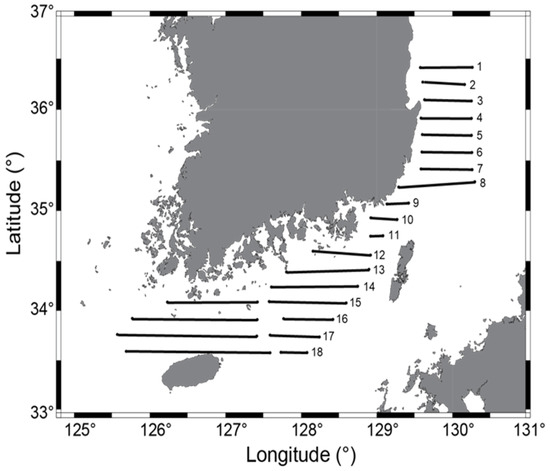
Figure 1.
Acoustic survey stations in the East Sea and South Sea of Jeju.
Here, “N” represents the length of the survey line, “A” represents the area of the survey range, and the design ensured that the value of DOC did not fall below 6. The survey area in February was 2.26 km2, with a survey line length of 30,002 km, whereas in May, the survey area was 2.19 km2, with a survey line length of 29,126 km.
2.2. Acoustic Equipment System and Data Acquisitions
The acoustic system used in the survey was a split-beam EK80 scientific echo-sounder (Simrad, Kongsberg Maritime AS, Melbourne, Norway), which collected acoustic data for 18, 38, 70, 120 and 200 kHz. The sound data were recorded on the hard disk along with the sound data as location information from the DGPS (SPR-1400, Samyoung, Republic of Korea) receiver was being continuously received. The acoustic data collected in the field were later played back in the laboratory, and processed using an acoustic analysis software. Frequencies 18, 38, 70, 120, and 200 kHz were used to identify only the fish species in the collected acoustic data.
In order to identify fish species using acoustics, one needs biological information about the target organism, such as its body size and weight, and the frequency of its feeding. Therefore, in this study, anchovies were sampled using bottom trawls and set net. Anchovy samples were collected in February using bottom trawls deployed on the research vessel R/V Tamgu No. 23; in May, anchovy samples were collected using purse set net in South Sea waters.
2.3. Acoustic Data Analysis
Later, a hydro-acoustic data processing software (Echoview V 8.0, Echoview Software Pty Ltd., Hobart, Australia) was used to analyze and process the acoustic data collected during the survey. Acoustic data at 18, 38, 70, 120, and 200 kHz were collected for distinguishing the anchovies. When collecting acoustic data using scientific echo-sounders, the loss of normal echo signals due to various acoustic noises is a problem. In this study, acoustic noise emerged in the form of background and impulse noises. Background noise occurs when the depth of the survey is outside the detection range of the used frequency, and it is relatively stronger in acoustic intensity. Background noise is removed by converting the value of the data sample to −999 dB if the signal-to-noise ratio is greater than the threshold value when the artificial noise is subtracted from the data sample in the specified area, and this method is called time-varied threshold [14].
Impulse noise is caused by interference from sounding equipment on other vessels, and is characterized by a vertical pattern of irregular, thick rain. Impulse noise was initially eliminated by setting data exclusion lines between the sea surface and sea floor, thereby excluding unnecessary portions from data processing in the denoising algorithm. Subsequently, a smoothing process was used, wherein vertical sample values within a specified range were averaged; if the resulting value exceeded the set threshold value, they were considered as candidates for noise. Therefore, in this study, the threshold value was set to −150 dB. The values identified as candidates for noise were used to differentiate between noise and bio-echo using the two-sided comparison method [11]. For the given data samples a, b, and c, the two-sided comparison method was used to compare samples a and c and to define sample b. The parameter values for removing background noise and impulse noise are shown in Table 1 and Table 2.

Table 1.
Parameters to remove background noise.

Table 2.
Parameters to remove impulse noise.
In order to separate the echoes of anchovies using multi-frequency, it is necessary to understand the frequency characteristics and differences for frequencies 18, 38, 70, and 120 kHz. Here, the frequency difference represents the difference in Mean Volume Backscattering Strength (MVBS) in multi-frequency, and ∆MVBS is calculated by comparing the frequency-specific TS of the target species and subtracting the frequencies with lower TS from the frequencies with higher TS in order to get a positive value. For the new echograms at 18, 38, 70, 120, and 200 kHz made from the matrixes, ∆MVBS can be expressed as the following Equation (4).
To extract only the acoustic signal of anchovies from the acoustic data, the acoustic data were first processed using the data processing flow chart shown in Figure 2, and then, extracted using the frequency differences. The extracted echoes were integrated over EDSU (Elementary Distance Sampling Unit) intervals of 1.0 n.mile and expressed as extracted area scattering coefficient values per nautical mile.
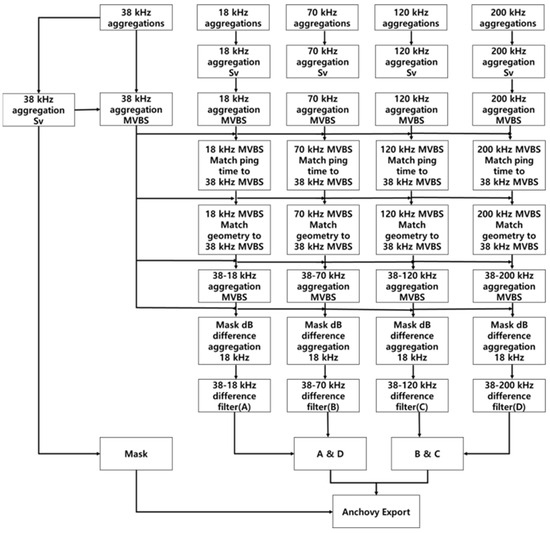
Figure 2.
Data flow of acoustic data analysis at 18, 38, 70, 120, 200 kHz for anchovies.
2.4. Estimating the Density of Anchovies Using Acoustics Methodology
We used the nautical area scattering coefficient (NASC) values converted from volume backscattering strength (SV) data drawn at one nautical mile from the fish finder in order to estimate the density of euphausiids and copepods using acoustics. Equation (5) shows the conversion relationship from SV to NASC.
The NASC value is the linear combination of the signals received from the aquatic organisms within a volume, so the density ( g m2) of the target organism can be obtained by dividing the average NASC value by the TS of the target fish (Equation (6)). The TS and backscattering cross-section (), depending on the target organism’s body length (L, mm), can be expressed as Equations (7) and (8), respectively.
The target organism’s body length (L, cm)-weight (w, g) relationship is shown in Equation (9).
The target organism’s density () can be obtained by dividing the average NASC within the volume at one nautical mile distance by the backscattering cross-section () and multiplying the weight (Equation (9)). All, except NASC on the right side of Equation (10), are conversion factors (CFs) that calculate the density from the acoustic data, which considers the backscattering cross-section and body length-weight of the target organism. Average values were used for the backscattering cross-section and for the weight of the target organism.
The average target organism density () of the entire investigated sea area was the weighted mean of each transect’s average density data, as shown in Equation (11).
where is the average density of the i transect, is the EDSU of the ith transect, and N is the number of transects [15].
3. Results
3.1. Species Identification of Anchovies
After removing the acoustic noise, all fish schools that appeared in the echogram were detected using the fish school detection module (Table 3), and the size of the anchovy schools in the echogram was estimated and parameterized. The parameter values for the anchovy school size are shown in Table 4.

Table 3.
Parameters to detect fish.

Table 4.
Parameters to detect anchovy school.
In order to identify fish species using acoustics, biological information about the species such as the target organism’s body length and weight, and length of the frequency number are required. Anchovies collected in the February survey seawater ranged from 10.0 to 12.5 cm in length, with an average length of 11.1 cm, and an average weight of 6.2 g. The length distribution of anchovies collected in the May survey seawater ranged from 8.4 to 15.8 cm, with an average length of 11.3 cm, and an average weight of 10.8 g (Figure 3). The length–weight relations for anchovies were found to be () (Figure 4).
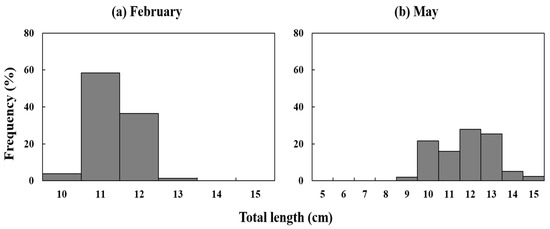
Figure 3.
Length frequency distribution of anchovies: (a) February, (b) May.
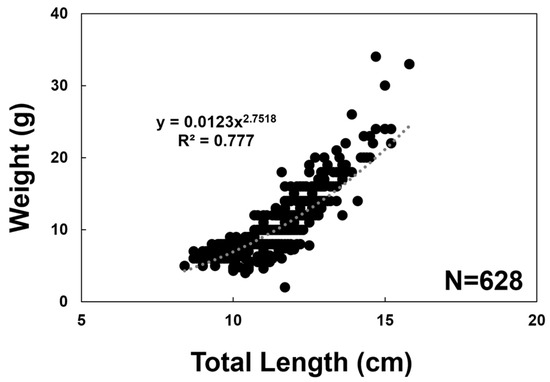
Figure 4.
Length–weight relationships for anchovies.
The size of the collected anchovies and the acoustic scattering intensity values estimated using the theoretical model were applied to set the dB-difference interval. The dB-difference intervals per frequency were shown as follows: −2.1 dB ≤ ΔMVBS18–38 ≤ 4.4 dB, −9.7 dB ≤ ΔMVBS70–38 ≤ 1.3 dB, −10.2 dB ≤ ΔMVBS120–38 ≤ 2.3 dB, and −10.7 dB ≤ ΔMVBS200–38 ≤ 0.3 dB (Table 5). Once the dB-difference is clear, a range of its value is set to create a date range bitmap, a mask with echoes set in this range and a cell size that matches the echoes per frequency. The echo that matches the denoised echo was then divided by the ping interval and considered as the echo of the anchovies. The echo signal of the extracted anchovy school is shown in Figure 5.

Table 5.
dB-difference section of anchovies.

Figure 5.
Echo signals of anchovies using multi-frequency.
3.2. Temporal and Spatial Distribution of Anchovies
The day and night distribution of anchovy fish school found using the dB-difference method are shown in Figure 6 and Figure 7, respectively. During the daytime in February, anchovies showed a relatively high distribution in the waters off the coast of Ulsan in the East Sea, Busan, and Tongyeong, with an average NASC value of 190.97 m2/n.mile2. At night, anchovies were evenly distributed in low abundance between the East and South Korean coastal waters. The average NASC value for anchovies at night was 28.54 m2/n.mile2. During the daytime in May, anchovies showed a relatively high distribution in the waters off the coast of Ulsan in the East Sea, Busan in the West Sea, and Namhae in the South Sea, with an average NASC value of 123.76 m2/n.mile2. At night, anchovies showed a relatively high distribution in the coastal waters of Busan and the central waters of the South Sea, and an evenly low distribution in other waters. The average NASC value for anchovies at night was 108.97 m2/n.mile2.
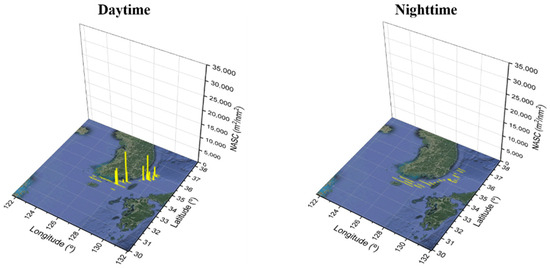
Figure 6.
The spatio-temporal distribution and density estimation of anchovies in February.
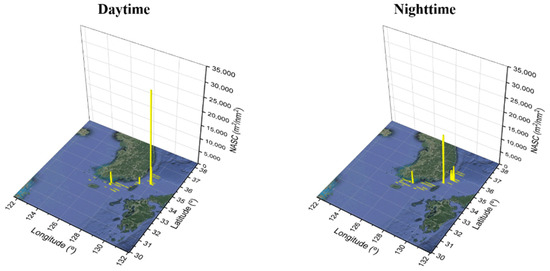
Figure 7.
The spatio-temporal distribution and density estimation of anchovies in May.
4. Discussion
The TS function, body length and weight, nautical area scattering coefficient (NASC) of the fish were used to determine the density of anchovies. To estimate the density of anchovies using acoustic data, the TS of anchovies from previous studies were used (Table 6). We chose the values from these studies because they were conducted with anchovies found in the waters around Korea, and the body size of the anchovies used in the experiments is similar to the body size of the anchovies in this study. Using the −72.9 dB from the previous study by [7], the average density of anchovies in February was found to be 3.43 g/m2, and the average density of anchovies in May was found to be 6.02 g/m2. The average density of anchovies using the −71.6 dB from the previous study by [16] was found to be 2.54 g/m2 in February and 4.46 g/m2 in May. The average density of anchovies using the −72.5 dB from the previous study by [17] was found to be 3.13 g/m2 in February and 5.49 g/m2 in May (Table 7). In general, anchovy densities were relatively higher in May than in February, which may be due to the fact that anchovies enter the southern coastal waters and the southern East Sea to spawn between April and June when water temperatures increase [18,19]. Also, anchovies are turbulent fish that seek out the right water temperature, which may explain the relatively higher densities in May, as water temperatures were higher in May, while they were lower in February.

Table 6.
Target strength of anchovies from previous studies.

Table 7.
Monthly density distribution of anchovies.
In this study, a single target detection method was used to determine the vertical day-night distribution of anchovies by month. During the daytime in February, anchovy schools were found to be distributed from the surface to 70 m of water level, while at night, anchovy schools were found to be predominantly distributed between 30 and 50 m of water level, with a maximum distribution at 150 m. During May, anchovy stocks were found to be distributed from the surface to 150 m depth of water, with the main distribution found in 80–120 m. At night, anchovy schools were found to be mainly distributed at depths of 30–50 m and 100–140 m (Figure 8). Similar to our findings, anchovies were found in the 50–70 m water level during the day and in the 30–100 m water level from the surface at night in a previous study by Lee et al. [20] Moreover, in the study by Kang et al. [21], adult anchovies were found to be predominantly distributed at depths of 60–80 m. In a study by Lee [22], it was found that anchovies distributed along the West Coast of South Korea inhabited the entire water column from the surface to near the seafloor during the daytime. In the present study, anchovies were found to be distributed in all water columns during the month of May, probably because anchovies are poor swimmers and are presumed to be distributed over the surface because of the ocean currents. In the study by Kim [23], anchovies were found to be chiefly distributed at a depth of 50 m. Thus, during the day, anchovies are mainly distributed in the water layer at depths of 30–50 m, and at night, they are distributed in the water level at depths of 30–150 m, which is believed to be due to the day–night vertical movement of anchovies in search of the thermocline layer and food. In addition, the body length distribution of anchovies collected in February and May were presumed to be adults, and they were found in all water columns because anchovies have the ecological characteristic of moving from the surface to the bottom as they grow from larval fish to adults.
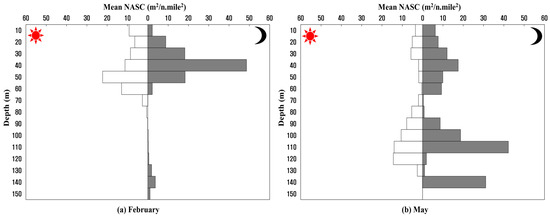
Figure 8.
The vertical distribution of anchovies as mean NASC values: (a) February, (b) May.
5. Conclusions
This study utilized the dB-difference method to identify the echo signals of anchovies in the echogram, and identified the day and night distribution characteristics of anchovies. Using the difference in frequency characteristics of 18, 38, 70, 120, and 200 kHz, the dB-difference intervals of −2.1 dB ≤ ΔMVBS18–38 ≤ 4.4 dB, −9.7 dB ≤ ΔMVBS70–38 ≤ 1.3 dB, −10.2 dB ≤ ΔMVBS120–38 ≤ 2.3 dB, and −10.7 dB ≤ ΔMVBS200–38 ≤ 0.3 dB were set to extract the echo signals of anchovies. The echo signals of anchovies extracted using the frequency difference method were integrated at EDSU intervals of 1.0 n.mile, and expressed as an extracted area scattering coefficient value per nautical mile to understand the distribution characteristics of anchovies. The results showed that in the East and South seas, anchovies had a relatively higher inshore distribution than offshore, and a higher distribution density in May when the water temperature was high as compared to that in February. Furthermore, anchovies were found to be mainly distributed in the water level at depths of 30–70 m during the daytime, whereas they were found at depths of 30–50 m and up to 150 m at night. The results of this study are expected to serve as a basis for further research on species identification of anchovies using acoustics.
Author Contributions
Conceptualization, G.P. and K.L.; methodology, G.P.; software, W.O.; validation, H.L., E.Y., S.O. and S.L.; formal analysis, G.P.; investigation, E.Y.; resources, C.k.L.; data curation, G.P., S.O. and S.L.; writing—original draft preparation, G.P; writing—review and editing, E.Y; visualization, G.P; supervision, K.L.; project administration, K.L.; funding acquisition, J.S.K. All authors have read and agreed to the published version of the manuscript.
Funding
This work was supported by the National Institute of Fisheries Science, Korea (No. R2023001) and was partially supported by the project titled “Development of Advanced Science and Tech-nology for Marine Environmental Impact Assessment” of Korea Institute of Marine Science & Technology Promotion(KIMST) funded by the Ministry of Oceans and Fisheries(KIMST-20210427).
Institutional Review Board Statement
Not applicable.
Informed Consent Statement
Not applicable.
Data Availability Statement
Not applicable.
Acknowledgments
This work was supported by the National Institute of Fisheries Science, Korea (No. R2023001) and was partially supported by the project titled “Development of Advanced Science and Technology for Marine Environmental Impact Assessment” of Korea Institute of Marine Science & Technology Promotion (KIMST) funded by the Ministry of Oceans and Fisheries (KIMST-20210427). We are grateful to two anonymous reviewers for their help in improving this paper.
Conflicts of Interest
The authors declare no conflict of interest.
References
- Kim, M.J.; Youn, S.H.; Kim, J.Y.; Oh, C.W. Feeding characteristics of the Japanese anchovy, Engraulis japonicus according to the distribution of zooplankton in the coastal waters of southern Korea. Korean J. Environ. Biol. 2013, 31, 275–287. [Google Scholar] [CrossRef]
- Lee, C.R.; Park, C.; Moon, C.H. Appearance of cold water and distribution of zooplankton off Ulsan-Gampo area, eastern coastal area of Korea. Sea J. Korean Soc. Ocean. 2004, 9, 51–63. [Google Scholar]
- Kang, M.H.; Seo, Y.I.; Oh, T.Y.; Lee, K.H.; Jang, C.S. Estimating the biomass of anchovy species off the coast of Tongyeong and Yeosu in South Korea in the spring and winter of 2013 and 2014. J. Korean Soc. Fish. Technol. 2015, 51, 86–93. [Google Scholar] [CrossRef]
- NFRDI. National Institute of Fisheries Science. 2022. Available online: https://www.mof.go.kr/doc/ko/selectDoc.do?docSeq=49328&searchDeptName=&meuSeq=971&searchEndDate=&searchEtc1=&searchEtc2=&searchEtc3=&searchEtc4=&searchEtc5=&curentPageNo=1&searchSelect=content&searchStartDate=&recordCountPerPage=&bbsSeq=10&searcValue=%EA%B8%B0%ED%9B%84 (accessed on 7 July 2023).
- Han, I.; Oh, W.; Yoon, E.A.; Suh, Y.; Lee, K.; Shin, H. The relationship between fish and zooplankton in south-western region of the East Sea using hydro-acoustics. J. Korean Sci. Fish. Ocean Technol. 2017, 53, 376–385. [Google Scholar] [CrossRef]
- Kang, D.H.; Hwang, D.J.; Mukai, T.; Iida, K.; Lee, K.H. Acoustic target strength of live Japanese common squid (Todarodes pacifica) for applying biomass estimation. J. Korean Fish. Aquat. Sci. 2004, 37, 345–353. [Google Scholar] [CrossRef]
- Yoon, S.C.; Youn, S.H.; Shim, M.J.; Woon, Y.Y. Characteristics and variation trend of water mass in offshore of the east coast of korea during last 10 year. J. Korean Soc. Mar. Environ. 2017, 20, 193–199. [Google Scholar] [CrossRef]
- Yang, Y.S.; Lee, K.H.; Hwang, B.K.; Lee, H.; Kim, I.O.; Kim, S. Backscattering strength and vertical distribution of dominant fishes in inland waters by hydroacoustics. J. Korean Soc. Fish. Technol. 2004, 50, 476–486. [Google Scholar] [CrossRef]
- Choi, S.G.; Yoon, E.A.; Han, I.; Oh, W. Comparison of Echogram Analysis Methods for Evaluating the Sound-scattering Layer. J. Korean Fish. Aquat. Sci. 2016, 49, 856–861. [Google Scholar]
- Kang, M.; Furusawa, M.; Miyashita, K. Effective and accurate use of difference in mean volume backscattering strength to identify fish and plankton. ICES J. Mar. Sci. 2002, 59, 794–804. [Google Scholar] [CrossRef]
- Miyashita, K.; Aoki, I.; Seno, K.; Taki, K.; Ogishima, T. Acoustic identification of isada krill, Euphausia pacifica Hansen, off the Sanriku coast, north-eastern Japan. Fish. Oceanogr. 1998, 6, 266–271. [Google Scholar] [CrossRef]
- McKelvey, D.R.; Wilson, C.D. Discriminant classification of fish and zooplankton backscattering at 38 and 120 kHz. Trans. Am. Fish. Soc. 2006, 135, 488–499. [Google Scholar] [CrossRef]
- Yoon, G.D.; Kim, Z.G.; Choi, Y.M. Acoustic Target Strength of the Pelagic Fish in the Southern Waters of Korea I. In situ Measurement of Target Strength of Anchovy (Engraulis japonica). J. Korean Soc. Fish. Technol. 1996, 29, 107–114. [Google Scholar]
- Park, G.C.; Han, I.S.; Oh, W.S.; Lee, K.H. Analysis on the estimating of fishery resources using hydro-acoustic. J. Korean Soc. Fish. Technol. 2022, 58, 223–229. [Google Scholar] [CrossRef]
- Jolly, G.M.; Hampton, I. A stratified random transect design for acoustic surveys of fish stocks. Can. J. Fish. Aquat. Sci. 1990, 47, 1282–1291. [Google Scholar] [CrossRef]
- Zhao, X.; Wang, Y.; Dai, F. Depth-dependent target strength of anchovy (Engraulis japonicus) measured in situ. ICES J. Mar. Sci. 2008, 65, 882–888. [Google Scholar] [CrossRef][Green Version]
- Zhu, D.S.; Iversen, S.A. Anchovy and other fish resources in the Yellow Sea and East China Sea. Mar. Fish. Res. 1990, 11, 1–143. [Google Scholar]
- Lee, C.I.; Jang, L.H.; Park, S.E. Influence of water temperature during the main spawning period on anchovy catch. J. Korean Fish. Aquat. Sci. 2009, 42, 297–301. [Google Scholar] [CrossRef]
- Moon, S.Y.; Baeck, G.W.; Lee, M.H.; Kim, H.Y.; Jung, K.M. Reproductive Characteristics of Pacific Anchovy Engraulis japonicus from the Southern Waters of Korea. J. Korean Fish. Aquat. Sci. 2022, 55, 927–937. [Google Scholar]
- Lee, E.K.; Yoo, J.M.; Kim, S.; Lee, Y.C. Verical distribution of anchovy, Engraulis japonicus larvae in the Korea strait. Korean J. Ichthyol. 1996, 8, 47–56. [Google Scholar]
- Lee, H.B.; Kang, D.H.; Im, Y.J.; Lee, K.H. Distribution and abundance of Japanese anchovy Engraulis japonicus and other fishes in asan bay, korea, estimated hydroacoustic survey. J. Korean Soc. Fish. Technol. 2014, 47, 671–681. [Google Scholar] [CrossRef]
- Lee, H.; Choi, S.G.; Lee, K.; Lee, J.B.; Lee, J.H.; Choi, J.H. A study on noise removal technique for acoustic data from a fishing boat. J. Korean Soc. Fish. Technol. 2015, 51, 340–347. [Google Scholar] [CrossRef]
- Kim, D.S. Fish Distribution Characteristics Using a Hydro-Acoustic Survey around Yeongil Bay. Master’s Thesis, Pukyong National University, Busan, Korea, 2021; pp. 1–30. [Google Scholar]
Disclaimer/Publisher’s Note: The statements, opinions and data contained in all publications are solely those of the individual author(s) and contributor(s) and not of MDPI and/or the editor(s). MDPI and/or the editor(s) disclaim responsibility for any injury to people or property resulting from any ideas, methods, instructions or products referred to in the content. |
© 2023 by the authors. Licensee MDPI, Basel, Switzerland. This article is an open access article distributed under the terms and conditions of the Creative Commons Attribution (CC BY) license (https://creativecommons.org/licenses/by/4.0/).